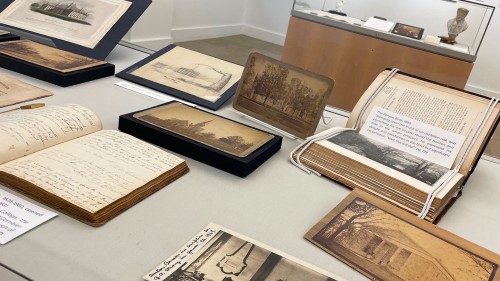Visit the Bulmash Exhibition Hall in Chalmers Library to explore the first fifty years of Kenyon's history through a collection of artifacts, letters, photographs and other archival materials curated by the staff of the College's Special Collections and Archives.
The exhibit will be on view until March 2024. Look out for additional exhibits throughout the College's bicentennial year that will focus on later periods in Kenyon's 200-year history.
About the Exhibit
"This will do." With this restrained sentiment, Philander Chase, the first Episcopal Bishop of Ohio, selected this Hill for the home of Kenyon College. The College itself, founded originally on Chase's farm in Worthington, had already been in existence for two years, but it would not be until 1828 that the first students set foot on the new campus. Though campus is hardly accurate, as it was only one building, the original Old Kenyon, that comprised the dormitories and classrooms of Kenyon College.
In this exhibit, the first of three exploring Kenyon's past in celebration of the College's bicentennial year, we look at the first fifty years of Kenyon's existence. 1824 through 1874 were tumultuous years for the foundling College. It went through nine presidents, suffered multiple financial setbacks, undertook five significant building projects and faced a national crisis with the American Civil War.
Each exhibition case examines a different aspect of life in the early years of the College, from the struggle to find funding to found the College in the first place, to what the students did at Chase's College in the Woods. We look at notable people who served as faculty and staff at Kenyon in those first fifty years, as well as alumni who went on to national and international significance. You can see what life looked like on the Hill and the construction of buildings beyond Old Kenyon to Ascension, Bexley and the creation of Middle Path.
As you view the exhibit, take a moment to reflect on the differences and similarities between then and now. Two hundred years have passed from the founding, but students are still forming groups, the campus continues new building projects, the community still faces the challenges of the outside world and Middle Path is still the main artery of life on the Hill. It is also important to consider what perspectives we have lost through two hundred years of history. You will not see many women in these first fifty years and just one student of color. But, of course, there were many more participating in life in Gambier. We cannot tell their stories since nothing of theirs was deemed important enough to save, but we can hear their silence during our celebration of all Kenyon is and has been.
